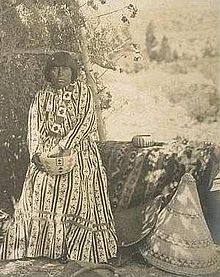Kucadikadi

Nellie Charlie, a member of the Kucadikadi band, early 20th century
|
|
| Regions with significant populations | |
|---|---|
|
|
|
| Languages | |
| Northern Paiute language, English language | |
| Religion | |
| Traditional Tribal Religion, Christianity | |
| Related ethnic groups | |
| other Northern Paiute people, Mono tribe (including Owens Valley Paiute),Western Shoshone, Yokuts |
The Kucadikadi are a band of Northern Paiute people who live near Mono Lake in Mono County, California. They are the southernmost band of Northern Paiute.
Kucadikadi means "eaters of the brine fly pupae." They are also known as the Kutsavidökadö, Koza'bittukut'teh, Kotsa'va, Mono Lake Paiute, Mono Basin Paiute, and Kuzedika. Lamb gives the Mono language name as kwicathyhka', "larvae eaters", or Mono Lake Paviotso. The term "Mono Lake Paiute," a holdover from early anthropological literature, has proven problematic.
The Kucadikadi's homeland surrounds Mono Lake in eastern California, but they traditionally traveled to Walker Lake, Nevada for seasonal subsistence activities. Mono Lake is a high piedmont area of the Sierra Nevada. The average elevation of the Mono Lake basin is around 6,400 feet (2,000 m) above sea level. The surrounding mountains range from 9,000 to 13,000 ft (2,700 to 4,000 m) in elevation. Mono Lake is extremely saline and is home to several waterfowl species and the brine fly, or Ephydra hians or Hydropyrus hians, from which the band takes its name.Pinus monophylla or Piñon pine has been an importance source of food, as were jackrabbits, deer, mountain sheep, and the Coloradia pandora moth.
The extended family was the bands basic social units, which moved together as a group. They traded with Owens Valley Paiute and Western Mono.
Three late 19th-century winter houses belonging to the tribe have been excavated by archaeologists. They are conical houses constructed with posts of Utah juniper or Juniperus osteosperma. Winter of houses of this type, called tomogani, were built by the band up to 1920.
...
Wikipedia
